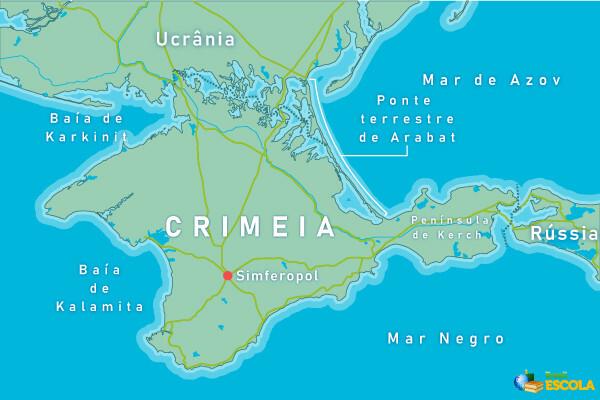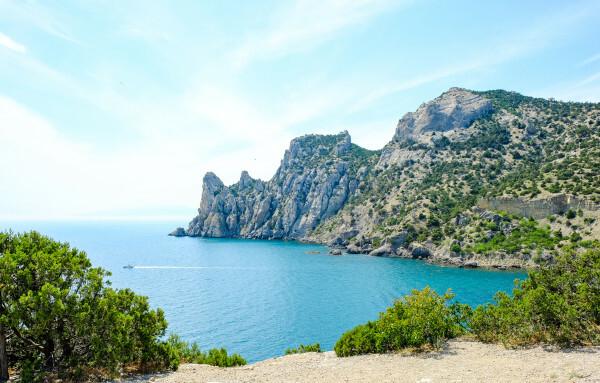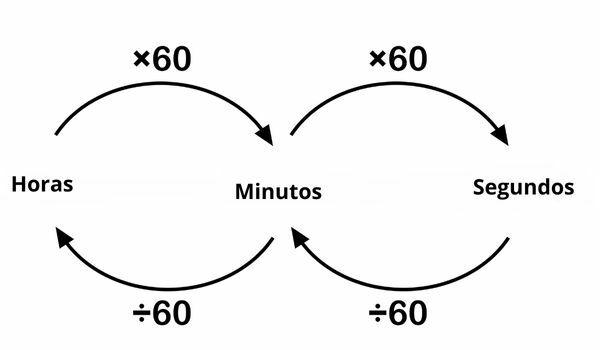Crimea, or Autonomous Republic of Crimea, is a peninsula in eastern Europe bathed by the Black Sea and located south of Ukraine and southwest of Russia. It has a population of 2.4 million inhabitants. The administrative headquarters of Crimea is in the city of Simferopol.
The peninsula has a predominance of temperate climate and relief formed by plains, with mountains to the east. It is situated in a geographical position of great strategic value for neighboring countries, being at the center of a geopolitical conflict between Russia and Ukraine for its sovereignty.
Know more: What are the causes of the conflict between Israel and Palestine?
Summary about Crimea
It is an autonomous republic in Eastern Europe, bordered by the Black Sea.
It is separated from Russia by the Kerch Strait, and has a land connection with Ukraine through the Isthmus of Perekop.
It is a Ukrainian territory annexed by Russia in 2014. The geopolitical disputes over the peninsula are known as the Crimean Question.
Its capital is the city of Simferopol.
Have climate temperate and subtropical, with relief characterized by plains in most of the peninsula and mountains in the east.
the supply of Water it happens, in part, by Ukrainian rivers due to climatic conditions in most of Crimea, which has low rainfall.
Its population is now over 2.4 million, and Russians make up 67% of it.
Its economy is based on tourism, the food and beverage industry, such as wine, and the agriculture, notably in grain production.
It is in a strategic position, and its ports are widely used for international trade and for the territorial protection of neighboring countries.
Do not stop now... There's more after the ad ;)
General information about Crimea
Official name: Autonomous Republic of Crimea
Gentle: Crimean, Crimean
Territorial extension: 27,000 km²
Localization: Eastern Europe, south of Ukraine
Capital: simferopol
-
Climate:
tempered;
subtropical.
Government: autonomous republic
Administrative division: districts and municipalities
-
Language:
Russian;
Ukrainian.
-
Religions:
orthodox Christian;
islamic.
Population: 2,416,856 inhabitants
Demographic density: 84.6 inhab./km²
Currency: Russian ruble (since 2014)
Gross Domestic Product (GDP): $7 billion
per capita GDP: $3000
Gini: 0,330
Timezone: GMT+4
Crimean Etymology
Before receiving its current name, Crimea was called Taurica by the greeks and also by the Romans in THEseniority. The current name is derived from the Tatars, an ethnic group of Turkish origin that arrived in that region around the 13th century, later forming the Crimean Khanate.
The word “Crimea” is derived from the Turkish “Qirim”, from the name of the city that served as the capital during the rule of the Khanate of the Golden Horde, Staryi Krym. In its original meaning, the word refers to mound or mountains. Its spelling comes from its form in Italian, “Crimea”.
Crimea map

Crimea geography
Crimea is a peninsula located in Eastern Europe, surrounded by the waters of the Black and Azov seas. The Arabat Land Bridge separates the northeast of this peninsula from the Sea of Azov, an area where several inlets called Syvash or Putrid Sea were formed.
Crimea is located in the south of Ukraine, and is connected to that country by several points. land, including the Isthmus of Perekop, and west of Russia, from which it is separated by the strait from Kerch. The total area of the peninsula is approximately 27 thousand km². Next, the analysis of some of its main physiographic characteristics.
→ Climate of Crimea
Two climatic types are predominant in Crimea: the tempered continental it's the subtropical. The first occurs in the lowlands that comprise most of this peninsula, especially in the center and north. It is characterized by low rainfall, winters mild and hot, dry summers.
In the mountainous region of the east, there is a predominance of subtropical climate, when temperatures vary from mild, in the summer, to very low, in winter (minimum of -3 ºC), and the rains are more abundant, reaching 1600 mm per year.
→ Crimean relief
The Crimean peninsula can be compartmentalized into three regions. The first comprises 75% of the peninsula and corresponds to the area immediately south of Ukraine. It is composed of extensive plains that dip gently in a south-north direction. The second region corresponds to the Kerch Strait, formed by Hills.
The third and last region, located to the east, is characterized by mountains, the Crimean mountains, where the highest terrains of the peninsula are located. On the eastern coast, the steep dip of the mountains gives rise to cliffs and cliffs. The coastal plain in this region is quite narrow.

→ Vegetation of Crimea
The vegetation cover of Crimea is formed by steppes to the west, where the main agricultural crops of the peninsula are concentrated, and on the Kerch Strait. To the east, in the mountainous region, are the temperate forests.
→ Hydrography of Crimea
the Crimea is bathed by sea black and by the sea from Azov. The latter is considered the shallowest in the world, with a depth of 14 meters. A part of the water supply of the western, driest region of Crimea, is carried out by conveying water from the Dnieper River stored in the Kakhovka reservoir. The main watercourse that flows exclusively through Crimea is the Salhyr River, which runs for 204 km until it flows into the Syvash region.
Demographics of Crimea
Crimea has a population of 2.416.856 population, according to a recent survey carried out by the Russian government. The population distribution in the territory is of the order of 84.6 inhab./km², occurring relatively homogeneously throughout the peninsula. Some cities, of course, have more inhabitants than other areas. Sevastopol, a coastal city located in the south of the peninsula, is the most populous of them, and today has approximately 341 thousand inhabitants. Next is the capital of Crimea, Simferopol, with 332,000 people.

The population of Crimea is made up of different ethnic groups, among which are:
Ukrainians;
Russians;
Crimean Tatars;
Belarusians;
Armenians;
Jews.
The Russians, almost a decade before the occupation promoted in 2014, formed about 60% of the population of the peninsula. Ukrainians accounted for 24%, while Tatars accounted for 10.2% of Crimean inhabitants. This composition, however, did not always take place this way. At the beginning of the 20th century, for example, half of the population was of Ukrainian origin, approximately 26% were Tatars, and the remaining groups made up the remaining 25%.
The Russian occupation of 2014 promoted an intense migration from the neighboring country to the peninsula, at the same time that a portion of those people who already lived in Crimea left the territory. Currently, the Russian population is equivalent to 68% of the region's residents, Ukrainians are approximately 16% and Tatars, 10.6%.
See too: China — the country with the most people in the world
Crimean economy
The Gross Domestic Product (GDP) of Crimea is estimated at around seven billion dollars. Since the Russian occupation in 2014, the ruble has become the official currency of the peninsula, replacing the Ukrainian currency. A special economic zone in Crimea was also established on the basis of Russian legislation.
This area would remain active for 10 years, but the Ukrainian government contests its creation based on the laws of the country, alleging a series of discriminatory actions aimed at Ukrainian citizens and/or against the occupation russian.
One of the main economic activities on the peninsula is tourism., responsible for a large part of that territory's revenues (approximately 25%, according to a 2014 survey). This activity came, in the early 2010s, to be considered a priority in Crimea's development strategy.
During this period, the flow of tourists varied between five and six million people a year, three times the population. Tourists from neighboring countries are the majority, mainly from Russia, and entry is mainly by land.
THE industry of Crimea stands out:
in mining;
in metallurgy;
in petrochemicals;
in the production of equipment for the generation and transmission of electric energy, mainly thermal and solar;
in civil construction;
in the production of engineering products aimed at sanitation services.
Crimea also excels in the food and beverage industry such as wine. In addition, agricultural activity is carried out in lowland areas, and its main crops are:
wheat;
corn;
potato;
sunflower seed.
History of Crimea
The occupation of the Crimean peninsula began around 10,000 BC. Ç. and was carried out by the Cimmerian peoples from the Sea of Azov. The following years were marked by the arrival of other populations to the region, highlighting the presence of the Greeks between the 5th and 4th centuries BC. Ç.
The Greeks established colonies along the coast of Crimea, concentrating some of its main polis near what is now Sevastopol, in the southwest of the territory. In many of these areas, there is a material record of the Greek presence in the region, which are the ruins of their old buildings.
The Romans also settled for a brief period in Crimea, giving rise to several nomadic populations that came concomitantly and later with them. In the 10th century of the current era, the Kingdom of Kiev dominated the region, but soon lost its sovereignty to other peoples. During this period, the advance of the Golden Horde Tatars on Crimea stands out, which had great importance in the cultural and political composition of the peninsula.
The territorial disputes so present in present-day Crimea began as early as the 15th century., after the establishment of the Crimean Khanate by the Tatars and, later, with the arrival of the ottoman empire the region.
In the 18th century, the Russian Empire carried out the expansion of its territory and reached the Crimea, fighting a series of local disputes for the domination of the peninsula. Finally, in 1783, Empress Catherine II, known as Catherine the Great, annexed Crimea to Russia and established a military base in Sevastopol.
The 19th century was marked by the Crimean War, conflict that extended from 1853 to 1856 for the domination of the peninsula. Later, the decline of the Russian Empire in 1917 led Crimea to declare its independence for a short time, returning two years later to the rule of the neighboring country. With the formation of Soviet Union, it became the Crimean Autonomous Soviet Socialist Republic.
THE Second World War and the period subsequent to it, more precisely the year 1944, were marked by the deportation of nearly 200,000 Crimean Tatars claiming to have collaborated with the Nazis during the conflict. Ten years later, the peninsula was transferred to the territory of Ukraine, a measure that was seen as a symbolic and, at the same time, strategic gesture to ensure an alliance in the region.
The end of the Soviet Union and a possible Russian attempt to retake Crimea motivated the signing of the Budapest memorandum, in 1994, by Ukraine, United Kingdom, U.S and Russia to secure Ukrainian territorial boundaries and domains.
However, the maintenance of the Black Sea Fleet, the name of the Russian Navy's Sevastopol unit, and an intense political crisis in Ukraine in 2013 resulted in the Russia's annexation of Crimea in 2014. The actions of the period still have repercussions in the region and have generated an escalation in the tension between Russia and Ukraine. To learn more, visit: Crimea question.
Crimean culture
The Crimean peninsula has a rich cultural heritage from the different peoples that once belonged to that territory. Elements derived from Turkish culture are mostly influential, with the strong presence of Tatars in the region, Russian and Ukrainian. This fact is reflected in the customs and traditions, as in the typical dances of the Tatar people, in the spoken language, as is the case of the prevalence of Russian, and in the religion. The Islamic and Orthodox faiths are mainly professed on the peninsula.

In its landscape it is possible to observe the ruins of buildings that date back to antiquity and recount the historical past of Crimea, as is the case of the Greek ruins. Big names from various artistic segments, such as writers, painters and musicians from Eastern European countries and other regions of the continent, lived in Crimea or were inspired by its unique beauty to produce their works. One of the main examples is the Crimean Sonnets, written by the Polish poet Adam Mickiewicz, during his exile on the peninsula in the 19th century.
Also know: What is the history of Islam?
Crimea's Infrastructure
Crimea's territory is considered strategic for countries like Russia and Ukraine., and one of the reasons why the peninsula receives this status is the various seaports installed along its coast. They are responsible for transporting agricultural products from neighboring countries, through which imports to Russia, for example, also pass. The waters of the region, in addition, are warm and provide navigation, serving the military and protection purposes of the region.
A large part of Crimea's water supply is provided by Ukrainian rivers and reservoirs, which is due to the drier climate that prevails over most of the peninsula. The same occurs with electric energy, coming from the neighboring country and generated from non-renewable sources, such as natural gas.
Today, after annexation to Russian territory, domestic demand for electricity has been supplemented by the country. The capital of Crimea is home to its main airport, and internally, transport is mainly done by the two highways that cross the peninsula.
government of Crimea
Crimea is a republic Thewhich was annexed by the Russian Federation in the year 2014 with the approval of Parliament, thus becoming part of Russian territory. The head of the executive branch of the peninsula is called the head of the republic and is elected by Parliament.
Fun facts about Crimea
O chiburekki is a typical dish of Crimean Tatars. It is a type of pastel or empanada filled with ground meat.
In 2019, the railway bridge connecting Crimea to Russia across the Kerch Strait was completed.
The flag of the Autonomous Republic of Crimea was adopted on September 24, 1992.
Another current flag on the peninsula is that of the Crimean Tatars, a blue flag with the symbol lady in yellow in the upper left corner. It was once used as the flag of Crimea during 1917 and 1918, a brief period when the territory declared its independence.
By Paloma Guitarrara
Geography teacher



